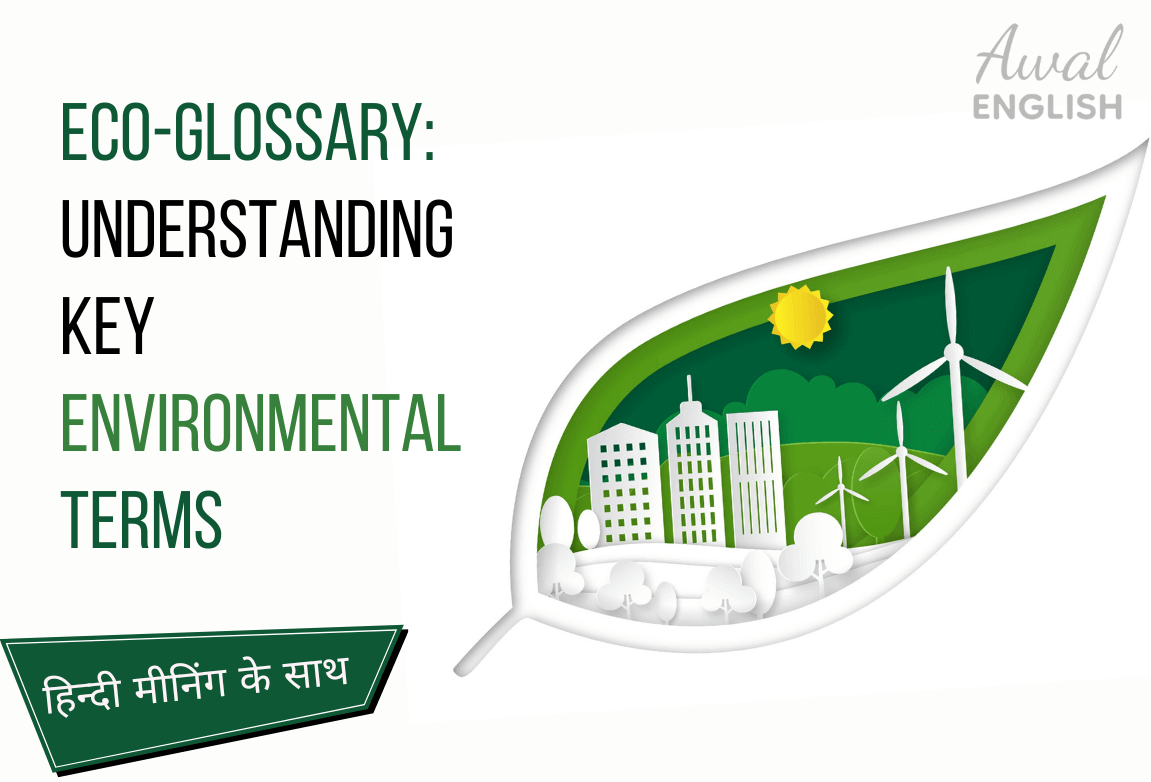
We all know how important our environment is, not only for us but for the flora and fauna too. It is important to conserve our environment and take steps to save it.
Here are a few terms to help us better understand our environment and its concerns.
Climate change:
Long-term alteration of temperature and typical weather patterns in a place.
Example: Due to climate change more severe and frequent weather changes are occurring.
जलवायु परिवर्तन के कारण अधिक गंभीर और लगातार मौसम परिवर्तन हो रहा है।
Global warming:
The high increase in the earth’s temperature due to the greenhouse effect.
Example: The burning of fossil fuels contributes to global warming.
जीवाश्म ईंधन के जलने से ग्लोबल वार्मिंग में योगदान होता है।
Carbon footprint:
The amount of greenhouse gases, especially carbon dioxide, released into the atmosphere by human activities.
Example: Scientists say that reducing our carbon footprint using renewable energy is essential for the climate.
वैज्ञानिकों ने कहा कि नवीकरणीय ऊर्जा का उपयोग कर हमारे कार्बन पदचिह्न को कम करना जलवायु के लिए आवश्यक है।
Greenhouse gases:
Gases, such as carbon dioxide and methane, that trap heat in the Earth’s atmosphere and contribute to the greenhouse effect.
Example: Industrial activities and deforestation lead to an increase in greenhouse gas emissions.
औद्योगिक गतिविधियों और वनों की कटाई से ग्रीनहाउस गैस उत्सर्जन में वृद्धि होती है।
Pollution:
Contamination of the environment, air, water, or soil with harmful substances.
Example: The increase in the number of cars and factories is the major cause of air pollution.
कारों और कारखानों की संख्या में वृद्धि वायु प्रदूषण का प्रमुख कारण है।
Air quality:
The level of purity or pollution in the air.
Example: Karnataka is the highest air quality state in India.
कर्नाटक भारत का उच्चतम वायु गुणवत्ता वाला राज्य है।
Water contamination:
The presence of harmful substances or pollutants in water sources, making it unsafe for consumption or use.
Example: Industrial waste dumped into the village river is causing water contamination.
औद्योगिक कचरे का गांव की नदी में फेंकना जल प्रदूषण का कारण बन रहा है।
Waste management:
The collection, treatment, and proper disposal of waste materials to minimize environmental impact.
Example: Our school has made rules on proper waste management.
हमारे स्कूल ने उचित अपशिष्ट प्रबंधन पर नियम बनाए हैं।
Recycling:
The process of converting waste materials into reusable materials.
Example: We should all try to recycle plastic bottles, paper, and aluminium cans to reduce the strain on natural resources.
प्राकृतिक संसाधनों पर दबाव को कम करने के लिए हम सभी को प्लास्टिक की बोतलों, कागज और एल्यूमीनियम के डिब्बे को रीसायकल करने का प्रयास करना चाहिए।
Renewable energy:
Energy derived from sources that are naturally replenished, such as solar, wind, and hydroelectric power.
Example: Investing in renewable energy technologies is crucial for reducing dependence on fossil fuels and mitigating the impacts of climate change.
जीवाश्म ईंधन पर निर्भरता कम करने और जलवायु परिवर्तन के प्रभावों को कम करने के लिए नवीकरणीय ऊर्जा प्रौद्योगिकियों में निवेश महत्वपूर्ण है।
Deforestation:
The clearing or removal of forests or trees, often for agricultural or commercial purposes.
Example: Often, deforestation is practised to clear the land for big buildings and malls.
बड़ी इमारतों और मॉल के लिए भूमि को साफ करने के लिए अक्सर वनों की कटाई का अभ्यास किया जा रहा है।
Conservation:
The protection, preservation, and careful management of natural resources and the environment.
Example: It is our duty to conserve our national biodiversity and wildlife.
हमारी राष्ट्रीय जैव विविधता और वन्य जीवन का संरक्षण करना हमारा कर्तव्य है।
Biodiversity:
The variety of plant and animal species within a particular habitat or ecosystem.
Example: The Amazon rainforest is known for its exceptional biodiversity, housing countless species of plants, animals, and insects.
अमेज़ॅन वर्षावन अपनी असाधारण जैव विविधता, पौधों, जानवरों और कीड़ों की अनगिनत प्रजातियों के आवास के लिए जाना जाता है।
Ecosystem:
A community of living organisms (plants, animals, and microorganisms) and their physical environment, functioning as a unit.
Example: The government has decided to do the construction of a dam in such a way that it does not disturb the ecosystem of aqua life.
सरकार ने एक बांध का निर्माण इस तरह से करने का फैसला किया है कि यह जलीय जीवन के पारिस्थितिकी तंत्र को परेशान न करे।
Sustainable development:
Development that meets the needs of the present generation without compromising the ability of future generations to meet their own needs.
Example: Efforts to promote sustainable development include renewable energy projects and eco-friendly urban planning.
सतत विकास को बढ़ावा देने के प्रयासों में अक्षय ऊर्जा परियोजनाएं और पर्यावरण के अनुकूल शहरी नियोजन शामिल हैं।
Ozone depletion:
The gradual thinning of the ozone layer, primarily caused by the release of certain chemicals into the atmosphere.
Example: The Montreal Protocol was an international agreement aimed at reducing the use of ozone-depleting substances.
मॉन्ट्रियल प्रोटोकॉल ओजोन-क्षयकारी पदार्थों के उपयोग को कम करने के उद्देश्य से एक अंतर्राष्ट्रीय समझौता था।
Environmental degradation:
The deterioration of the environment, typically caused by human activities such as pollution, deforestation, or overexploitation of natural resources.
Example: Deforestation is the major cause of environmental degradation, causing major wildlife diversity to lose their home.
वनों की कटाई पर्यावरण के क्षरण का प्रमुख कारण है, जिससे प्रमुख वन्यजीव विविधता अपना घर खो रही है।
Natural resources:
Materials or substances found in nature that have economic or practical value, such as minerals, water, or timber.
Example: We should practise sustainable development to save natural resources for future generations.
हमें भावी पीढ़ी के लिए भी प्राकृतिक संसाधनों को बचाने के लिए सतत विकास का अभ्यास करना चाहिए।
Ecological footprint:
The measure of human impact on the environment in terms of land and resources required to sustain an individual or population.
Example: By adopting energy-efficient practices and reducing waste, we can reduce our ecological footprint and lessen our environmental impact.
ऊर्जा-कुशल प्रथाओं को अपनाकर और कचरे को कम करके, हम अपने पारिस्थितिक पदचिह्न को कम कर सकते हैं और अपने पर्यावरणीय प्रभाव को कम कर सकते हैं।
Greenwashing:
Misleading or deceptive marketing practices that falsely portray a company or product as environmentally friendly or sustainable.
Example: Some companies engage in greenwashing by using eco-friendly labels without making significant changes to their production methods or materials.
कुछ कंपनियां अपने उत्पादन के तरीकों या सामग्रियों में महत्वपूर्ण बदलाव किए बिना पर्यावरण के अनुकूल लेबल का उपयोग करके ग्रीनवाशिंग में संलग्न हैं।





0 responses on "Eco-Glossary: Understanding Key Environmental Terms"